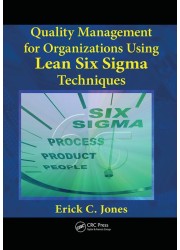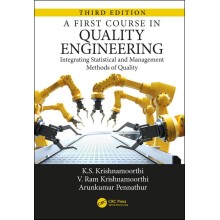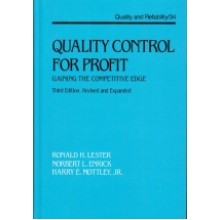Quality Management for Organizations Using Lean Six Sigma Techniques
Our Price: £112.50
Discount : 10%
Quantity:
-
Add to Compare
The next step in the evolution of the organizational quality field, Lean Six Sigma (LSS) has come of age. However, many challenges to using LSS in lieu of, in conjunction with, or integrated with other quality initiatives remain. An update on the current focus of quality management, Quality Management for Organizations Using Lean Six Sigma Techniques covers the concepts and principles of Lean Six Sigma and its origins in quality, total quality management (TQM), and statistical process control (SPC), and then explores how it can be integrated into manufacturing, logistics, and healthcare operations.
The book presents the background on quality and Lean Six Sigma (LSS) techniques and tools, previous history of LSS in manufacturing, and current applications of LSS in operations such as logistics and healthcare. It provides a decision model for choosing whether to use LSS or other quality initiatives, which projects should be selected and prioritized, and what to do with non-LSS projects. The author also details an integration model for integrating and developing integrated LSS and other quality initiatives, and common mathematical techniques that you can use for performing LSS statistical calculations. He describes methods to attain the different Six Sigma certifications, and closes with discussion of future directions of Lean Six Sigma and quality.
Case studies illustrate the integration of LSS principles into other quality initiatives, highlighting best practices as well as successful and failed integrations. This guide gives you a balanced description of the good, bad, and ugly in integrating LSS into modern operations, giving you the understanding necessary to immediately apply the concepts to your quality processes.
Preface
Acknowledgments
Introduction
Author
Section I : Modern Quality and Lean Six Sigma Overview
Chapter 1 : Overview of Modern Quality
Chapter 2 : Quality Gurus and Philosophies
Chapter 3 : Quality Awards and Standards
Chapter 4 : Six Sigma Without Lean
Chapter 5 : Lean
Chapter 6 : Lean Six Sigma
Section II : Deciding on Firm Qualities and Lean Six Sigma Initiatives
Chapter 7 : The Cost Approaches and Engineering Economics of Six Sigma Projecst
Chapter 8 : Lean Six Sigma and Firm Performance : A Managerial Perspective
Chapter 9 : Benchmarking High-Performing Six Sigma Companies
Chapter 10 : Six Sigma and HR : Getting the Right Talent and Industrial Engineers in Key Six Sigma Roles
Section III : The Science and Engineering of Lean Six Sigma
Chapter 11 : LSS Process, Steps, Tools, and Statistics
Chapter 12 : Fundamental Statistics and Basic Quality Tools
Chapter 13 : Define : Identifying and Organizing Six Sigma Projects for Success
Chapter 14 : Measure : Identifying Obtainable Data for Realistic Use
Chapter 15 : Analyze : Evaluating Data to Determine Root Causes
Chapter 16 : Improve : Utilizing Data to Predict Implementation Success
Chapter 17 : Control : Using Data to Maintain Success
Chapter 18 : Lean Integration into DMAIC
Chapter 19 : Nontraditional Tools for LSS : Work Measurement and Time Studies
Chapter 20 : DFSS Methods and Uses for Product- and Process-Oriented Research and Development
Section IV : Applying and Using Lean Six Sigma
Chapter 21 : Using Six Sigma to Evaluate Radio Frequency Technologies at NASA
Chapter 22 : Using Six Sigma to Evaluate Automatic Identification Technologies to Optimize Broken Case Warehousing Operations
Chapter 23 : Using Six Sigma to Implement RFID Automation at an Automotive Plant
Chapter 24 : Using Six Sigma to Evaluate Using Automated Inventory Tracking to Reduce in Processing Food Product Shortages at an International Food Processing Plant
Chapter 25 : Using Six Sigma to Improve Trucking
Chapter 26 : Using Six Sigma Logistics to Optimize a City's Supply Chain Inventory Supplies
Section V : Nontraditional Lean Six Sigma and Modern Quality Trends
Chapter 27 : Lean Six Sigma Certification and Belt Levels
Chapter 28 : Lean Six Sigma Practitioners, Consultants, and Vendors
Chapter 29 : Six Sigma Project Management : What to do After the Six Sigma Sponsorship Phase
Index
Write a review
Your Name:Your Review: Note: HTML is not translated!
Rating: Bad Good
Enter the code in the box below:
Copyright © 2014 Engineering Standards Bureau. All Rights Reserved.
Developed By Zoom Into Web







